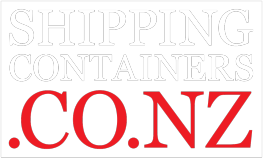The type of shipping container you buy will depend upon a number of factors such as condition of the container, and what you plan to use it for. If you’re looking to buy containers for storage, you will also need to determine which kind of container is appropriate for what you need to store. Some products have special storage requirements that need to be accommodated.
Shipping container materials and construction
When shipping containers are manufactured, they are made with COR-TEN®, a type of corrosion resistant alloy steel made by US Steel. It has become the standard used to manufacture shipping containers all over the world.
Shipping container types
There are several types of shipping containers available, so it is important to know which type will most closely match your needs. Here is a list of the different types of shipping containers:
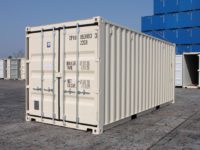
Dry Storage Shipping Container
This is the most common type of container, used for dry storage of items that aren’t adversely affected by changes in temperature. They are available in two heights, with standard height being about 2.6 meters, and a ‘high cube’ container being about 2.9 meters. These containers are available in different lengths, as follows: 4 meters (8ft), 3 meters (10ft), 6 meters (20ft), 9 meters (30ft), and 12 meters (40ft).
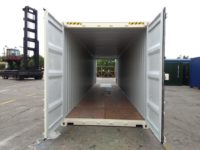
Double Door Shipping Container
Also known as a tunnel container, this shipping container has doors on both ends, allowing for easy, quick loading and unloading. Like the Open Top Container, they are available in 6 meter (20ft) and 12 meter lengths (40ft), with 2.6 meter (8ft 6in) or 2.9 meter (9ft 6in) height.
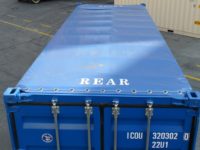
Open Top Shipping Container
This type of container has a removable tarpaulin top for top-loading of cargo and shipment of over-height cargo. These containers also come in both standard height at 2.6 meters (8fr 6in), and ‘high cube’ height at about 2.9 meters (9fr 6in) tall. They are available in 6 meter (20ft) and 12 meter (40ft) lengths. This container type is also available with a solid steel top.
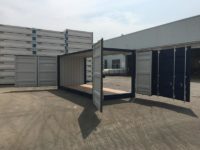
Side Open Shipping Container
These containers open from either one side, or both sides, as well as one end, again making it easy to load and unload materials such as bundled lumber. They are available in 6 meter (20ft) and 12 meter (40ft) lengths, with both 2.6 meter (8ft 6in) and 2.9 meter (9ft 6in) height.
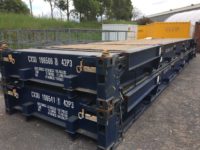
Flat Rack Shipping Container
These containers have either fixed OR collapsible sides, allowing them to be folded and stacked when not in use. These are used for shipping heavy, over-width and over-height items such as machinery, and are available in 6 meter (20ft) or 12 meter (40ft) lengths. They are built with a strong platform to support the heavy loads they carry.
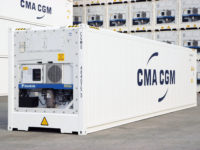
Refrigerated Shipping Containers
Also known as Reefers, these containers are designed specifically for transportation of refrigerated or frozen food products, and are available in 6 meter (20ft) and 12 meter (40ft) lengths. These units are well-insulated and maintain a constant temperature from shipper to destination, usually using 1 or 3 phase power.
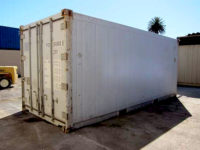
Insulated Shipping Container
A decommissioned refrigerated container that does not have operational hardware, insulated (also known as thermal containers) can still keep items cooler. They are available in the same heights as the reefers, with standard height being about 2.6 meters, and a ‘high cube’ container being about 2.9 meters. These containers are available in different lengths, usually: 6 meters (20ft) or 12 meters (40ft).
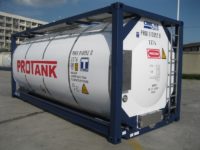
Tank Shipping Containers
These containers are built with tanks mounted in frames, and are designed to transport liquid products. They are generally treated with anti-corrosive materials both on the outside and inside to protect them. The tank component may be made from a heavy duty plastic or metal. Plastic tanks have to meet the rigorous standards required for shipment on ocean going vessel. Available in 6 meter (20ft) lengths.
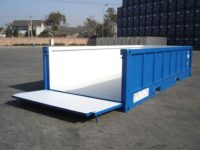
Half Height Shipping Containers
Used mostly for the transportation of bulk materials, such as coal, gravel, and other materials. These containers are usually made from steel and are built for rugged use, and in 6 meter (20ft) lengths. They’re also available with a hard or soft open top.
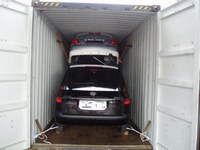
Car Carrier Shipping Containers
This container type is designed specifically for transporting cars. They have the associated equipment for safely loading and securing cars. Available in 2.9 meter height and 12 meter (40ft) length.
Shipping container condition
Shipping containers that are available for sale usually fall into four general categories: One Trip, Cargo Worthy, Wind and Watertight (WWT), and As Is.
-
One Trip Containers
These containers are loaded once and shipped, then sold once they are unloaded at their destination. All one trip containers have factory paint, and may be painted a single, solid color. These containers are considered “like new”, and have the highest resale value due to the fact that they are virtually brand new. If you are looking for a container you can put to work right away with no worries, this is the type to get.
-
Cargo Worthy Containers
This category of used container is certified as suitable for safe ocean transport of cargo. This certification is based on a careful inspection of the doors, ceiling, walls, floor, and overall structural integrity of the container. Rust may be visible in places, but it is generally surface rust only, and can easily be removed. Cargo worthy containers are likely to be painted with branding of the (former) owners on them.
-
A Grade/Wind and Watertight Containers
This container category has seen a fair amount of use and may show signs of wear, but is still wind and watertight. Visible rust is usually just surface rust, and can easily be taken care of. Paint jobs may vary, with bright colors or branding evident on the side. Nothing a little prep and paint won’t take care of.
-
As Is
Just what it says. Containers in this category are well worn, and may show signs of severe wear and/or damage. Severe rust is often a problem with these units, and can be costly to patch or repair. If you are looking into buying one of these containers, you really should inspect it yourself, with a flashlight and a pocket knife. Generally speaking, these containers are a half-step away from the scrap yard and best avoided when you’re looking to buy shipping containers.
Summing it all up
When figuring out what kind of container to buy, it’s important to know ahead of time what you will be using the container for. Once you have that worked out, you can choose the right container for the job. After taking a look at your budget to see what you can afford, you can then look at the different quality categories used containers fall into. Once you have determined the right container type, size, and shipping container condition, you’re ready to make that purchase.

